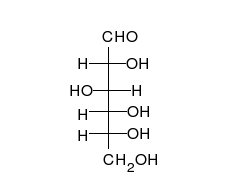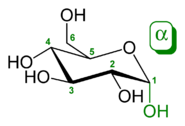Carbohydrate
From Wikipedia, the free encyclopedia

Carbohydrates (from 'hydrates of carbon') or saccharides (Greek σάκχαρον, sákcharon, meaning "sugar") are the most abundant of the four major classes of biomolecules. They fill numerous roles in living things, such as the storage and transport of energy (eg: starch, glycogen) and structural components (eg: cellulose in plants, chitin and cartilage in animals). Additionally, carbohydrates and their derivatives play major roles in the working process of the immune system, fertilization, pathogenesis, blood clotting, and development.[1]
Chemically, carbohydrates are simple organic compounds that are aldehydes or ketones with many hydroxyl groups added, usually one on each carbon atom that is not part of the aldehyde or ketone functional group. The basic carbohydrate units are called monosaccharides, such as glucose, galactose, and fructose. The general stoichiometric formula of an unmodified monosaccharide is (C·H2O)n, where n is any number of three or greater; however, not all carbohydrates conform to this precise stoichiometric definition (eg: uronic acids, deoxy-sugars such as fucose), nor are all chemicals that do conform to this definition automatically classified as carbohydrates.[2]
Monosaccharides can be linked together into what are called polysaccharides (or oligosaccharides) in almost limitless ways. Many carbohydrates contain one or more modified monosaccharide units that have had one or more groups replaced or removed. For example, deoxyribose, a component of DNA, is a modified version of ribose; chitin is composed of repeating units of N-acetylglucosamine, a nitrogen-containing form of glucose.
While the scientific nomenclature of carbohydrates is complex, the names of carbohydrates very often end in the suffix -ose.
Contents |
[edit] Monosaccharides

Monosaccharides are the simplest carbohydrates in that they cannot be hydrolyzed to smaller carbohydrates. The general chemical formula of an unmodified monosaccharide is (C•H2O)n, where n is any number of three or greater.
[edit] Classification of monosaccharides
Monosaccharides are classified according to three different characteristics: the placement of its carbonyl group, the number of carbon atoms it contains, and its chiral handedness. If the carbonyl group is an aldehyde, the monosaccharide is an aldose; if the carbonyl group is a ketone, the monosaccharide is a ketose. Monosaccharides with three carbon atoms are called trioses, those with four are called tetroses, five are called pentoses, six are hexoses, and so on. [3] These two systems of classification are often combined. For example, glucose is an aldohexose (a six-carbon aldehyde), ribose is an aldopentose (a five-carbon aldehyde), and fructose is a ketohexose (a six-carbon ketone).
Each carbon atom bearing a hydroxyl group (-OH), with the exception of the first and last carbons, are asymmetric, making them stereocenters with two possible configurations each (R or S). Because of this asymmetry, a number of isomers may exist for any given monosaccharide formula. The aldohexose D-glucose, for example, has the formula (C·H2O)6, of which all but two of its six carbons atoms are stereogenic, making D-glucose one of 24 = 16 possible stereoisomers. In the case of glyceraldehyde, an aldotriose, there is one pair of possible stereoisomers, which are enantiomers and epimers. 1,3-dihydroxyacetone, the ketose corresponding to the aldose glyceraldehyde, is a symmetric molecule with no stereocenters). The assignment of D or L is made according to the orientation of the asymmetric carbon furthest from the carbonyl group: in a standard Fischer projection if the hydroxyl group is on the right the molecule is a D sugar, otherwise it is an L sugar. Because D sugars are biologically far more common, the D is often omitted
[edit] Conformation

The aldehyde or ketone group of a straight-chain monosaccharide will react reversibly with a hydroxyl group on a different carbon atom to form a hemiacetal or hemiketal, forming a heterocyclic ring with an oxygen bridge between two carbon atoms. Rings with five and six atoms are called furanose and pyranose forms, respectively, and exist in equilibrium with the straight-chain form.
During the conversion from straight-chain form to cyclic form, the carbon atom containing the carbonyl oxygen, called the anomeric carbon, becomes a chiral center with two possible configurations: the oxygen atom may take a position either above or below the plane of the ring. The resulting possible pair of stereoisomers are called anomers. In the α anomer, the -OH substituent on the anomeric carbon rests on the opposite side (trans) of the ring from the CH2OH side branch. The alternative form, in which the CH2OH substituent and the anomeric hydroxyl are on the same side (cis) of the plane of the ring, is called the β anomer. You can remember that the β anomer is cis by the mnemonic, "It's always better to βe up". Because the ring and straight-chain forms readily interconvert, both anomers exist in equilibrium.
[edit] Use in living organisms
Monosaccharides are the major source of fuel for metabolism, being used both as an energy source (glucose being the most important in nature) and in biosynthesis. When monosaccharides are not immediately needed by many cells they are often converted to more space efficient forms, often polysaccharides. In many animals, including humans, this storage form is glycogen, especially in liver and muscle cells. In plants, starch is used for the same purpose.
[edit] Disaccharides

Two joined monosaccharides are called a disaccharide and these are the simplest polysaccharides. Examples include sucrose and lactose. They are composed of two monosaccharide units bound together by a covalent bond known as a glycosidic linkage formed via a dehydration reaction, resulting in the loss of a hydrogen atom from one monosaccharide and a hydroxyl group from the other. The formula of unmodified disaccharides is C12H22O11. Although there are numerous kinds of disaccharides, a handful of disaccharides are particularly notable.
Sucrose, pictured to the right, is the most abundant disaccharide, and the main form in which carbohydrates are transported in plants. It is composed of one D-glucose molecule and one D-fructose molecule. The systematic name for sucrose, O-α-D-glucopyranosyl-(1→2)-D-fructofuranoside, indicates four things:
- Its monosaccharides: glucose and fructose
- Their ring types: glucose is a pyranose, and fructose is a furanose
- How they are linked together: the oxygen on carbon number 1 (C1) of α-D-glucose is linked to the C2 of D-fructose.
- The -oside suffix indicates that the anomeric carbon of both monosaccharides participates in the glycosidic bond.
Lactose, a disaccharide composed of one D-galactose molecule and one D-glucose molecule, occurs naturally in mammalian milk. The systematic name for lactose is O-β-D-galactopyranosyl-(1→4)-D-glucopyranose. Other notable disaccharides include maltose (two D-glucoses linked α-1,4) and cellulobiose (two D-glucoses linked β-1,4).
[edit] Oligosaccharides and polysaccharides

Oligosaccharides and polysaccharides are composed of longer chains of monosaccharide units bound together by glycosidic bonds. The distinction between the two is based upon the number of monosaccharide units present in the chain. Oligosaccharides typically contain between two and nine monosaccharide units, and polysaccharides contain greater than ten monosaccharide units. Definitions of how large a carbohydrate must be to fall into each category vary according to personal opinion. Examples of oligosaccharides include the disaccharides mentioned above, the trisaccharide raffinose and the tetrasaccharide stachyose.
Oligosaccharides are found as a common form of protein posttranslational modification. Such posttranslational modifications include the Lewis and ABO oligosaccharides responsible for blood group classifications and so of tissue incompatibilities, the alpha-Gal epitope responsible for hyperacute rejection in xenotransplanation, and O-GlcNAc modifications.
Polysaccharides represent an important class of biological polymers. Their function in living organisms is usually either structure or storage related. Starch (a polymer of glucose) is used as a storage polysaccharide in plants, being found in the form of both amylose and the branched amylopectin. In animals, the structurally similar glucose polymer is the more densely branched glycogen, sometimes called 'animal starch'. Glycogen's properties allow it to be metabolized more quickly, which suits the active lives of moving animals.
Cellulose and chitin are examples of structural polysaccharides. Cellulose is used in the cell walls of plants and other organisms, and is claimed to be the most abundant organic molecule on earth.[4] It has many uses such as a significant role in the paper and textile industries, and is used as a feedstock for the production of rayon (via the viscose process), cellulose acetate, celluloid, and nitrocellulose. Chitin's structure has a similar structure, but has nitrogen containing side branches, increasing its strength. It is found in arthropod exoskeletons and in the cell walls of some fungi. It also has multiple uses, including surgical threads.
Other polysaccharides include callose or laminarin, chrysolaminarin, xylan, mannan, fucoidan, and galactomannan.
[edit] Nutrition

Foods high in carbohydrates include breads, pastas, beans, potatoes, bran, rice and cereals. Most such foods are high in starch. Carbohydrates require less water to digest than proteins or fats and are the most common source of energy in living things. Proteins and fat are necessary building components for body tissue and cells and are also a source of energy for most organisms.
Carbohydrates are not essential nutrients in humans: the body can obtain all its energy from protein and fats[5][6]. However, the brain and neurons generally cannot burn fat and need glucose for energy; the body can make some glucose from a few of the amino acids in protein and also from the glycerol backbone in triglycerides. Carbohydrate contains 3.75 and proteins 4 kilocalories per gram, respectively, while fats contain 9 kilocalories per gram. In the case of protein, this is somewhat misleading as only some amino acids are usable for fuel. Likewise, in humans, only some carbohydrates are usable for fuel; many monosaccharides and some disaccharides. Other carbohydrate types can be used, but only with the assistance of gut bacteria. Ruminants and termites can even process cellulose, which is indigestible to other organisms.
Based on the effects on risk of heart disease and obesity, the Institute of Medicine recommends that American and Canadian adults get between 40-65% of dietary energy from carbohydrates.[7] The Food and Agriculture Organization and World Health Organization jointly recommend that national dietary guidelines set a goal of 55-75% of total energy from carbohydrates, but only 10% directly from sugars (their term for simple carbohydrates).[8]
[edit] Classification
Carbohydrates can be classified as simple (monosaccharides and disaccharides) or complex (oligosaccharides and polysaccharides). The term complex carbohydrate was first used in the Senate Select Committee publication Dietary Goals for the United States (1977), where it denoted "fruit, vegetables and whole-grains".[9] Dietary guidelines generally recommend that complex carbohydrates, and such nutrient-rich simple carbohydrate sources such as fruit (glucose or fructose) and dairy products (lactose) make up the bulk of carbohydrate consumption. This excludes such sources of simple sugars as candy and sugary drinks.
The USDA's Dietary Guidelines for Americans 2005 dispensed with the simple/complex distinction, instead recommending fiber-rich foods and whole grains.[10]
The glycemic index and glycemic load concepts have been developed to characterize food behavior during human digestion. They rank carbohydrate-rich foods based on the rapidity of their effect on blood glucose levels. The insulin index is a similar, more recent classification method which ranks foods based on their effects on blood insulin levels, which are caused by glucose (or starch) and some amino acids in food. Glycemic index is a measure of how quickly food glucose is absorbed, while glycemic load is a measure of the total absorbable glucose in foods.
[edit] Metabolism
| This section requires expansion. |
| This section repeats, in whole or part, the text of other article(s) or section(s). Please discuss this issue on the talk page and conform with Wikipedia's Manual of Style by replacing the section with a link and a summary of the repeated text, or by spinning off the repeated text into an article in its own right. |
[edit] Catabolism
Catabolism is the metabolic reaction cells undergo in order to extract energy. There are two major metabolic pathways of monosaccharide catabolism:
Oligo/polysaccharides are cleaved first to smaller monosaccharides by enzymes called Glycoside hydrolases. The monosaccharide units can then enter into monosaccharide catabolism. In some cases, as with humans, not all carbohydrate types are usable as the digestive and metabolic enzymes necessary are not present. For instance, neither horses nor humans nor cats can digest and use cellulose, but ruminants and termites can.
[edit] Carbohydrate chemistry
Carbohydrates are reactants in many organic reactions. For example:
- Carbohydrate acetalisation
- Cyanohydrin reaction
- Lobry-de Bruyn-van Ekenstein transformation
- Amadori rearrangement
- Nef reaction
- Wohl degradation
- Koenigs-Knorr reaction
[edit] See also
| Wikimedia Commons has media related to: Carbohydrates |
- Biochemistry
- Bioplastic
- Gluconeogenesis
- Glycolipid
- Glycoprotein
- Low-carbohydrate diet
- No-carbohydrate diet
- Macromolecules
- Nutrition
- Pentose phosphate pathway
- Photosynthesis
- Sugar
|
|||||||||||||||||||||||||||
|
|||||
|
|||||||||||||||||||||||||||||||||||||||||||||||||||
[edit] References
- ^ Maton, Anthea; Jean Hopkins, Charles William McLaughlin, Susan Johnson, Maryanna Quon Warner, David LaHart, Jill D. Wright (1993). Human Biology and Health. Englewood Cliffs, New Jersey, USA: Prentice Hall. pp. 52–59. ISBN 0-13-981176-1.
- ^ Matthews, C. E.; K. E. Van Holde; K. G. Ahern (1999) Biochemistry. 3rd edition. Benjamin Cummings. ISBN 0-8053-3066-6
- ^ Campbell, Neil A.; Brad Williamson; Robin J. Heyden (2006). Biology: Exploring Life. Boston, Massachusetts: Pearson Prentice Hall. ISBN 0-13-250882-6. http://www.phschool.com/el_marketing.html.
- ^ N.A.Campbell (1996) Biology (4th edition). Benjamin Cummings NY. p.23 ISBN 0-8053-1957-3
- ^ Is dietary carbohydrate essential for human nutrition? - Westman 75 (5): 951 - American Journal of Clinical Nutrition
- ^ A High-Protein, High-Fat, Carbohydrate-Free Diet Reduces Energy Intake, Hepatic Lipogenesis, and Adiposity in Rats - Pichon et al. 136 (5): 1256 - Journal of Nutrition
- ^ Food and Nutrition Board (2002/2005). Dietary Reference Intakes for Energy, Carbohydrate, Fiber, Fat, Fatty Acids, Cholesterol, Protein, and Amino Acids. Washington, DC: The National Academies Press. Page 769. ISBN 0-309-08537-3
- ^ Joint WHO/FAO expert consultation (2003). Diet, Nutrition and the Prevention of Chronic Diseases (PDF). Geneva: World Health Organization. Pages 55-56. ISBN 92-4-120916-X
- ^ Joint WHO/FAO expert consultation (1998), Carbohydrates in human nutrition, chapter 1. ISBN 92-5-104114-8.
- ^ DHHS and USDA, Dietary Guidelines for Americans 2005, Chapter 7 Carbohydrates
[edit] External links
- Carbohydrates, including interactive models and animations (Requires MDL Chime)
- IUPAC-IUBMB Joint Commission on Biochemical Nomenclature (JCBN): Carbohydrate Nomenclature
- Carbohydrates detailed
- Carbohydrates and Glycosylation - The Virtual Library of Biochemistry and Cell Biology
- Consortium for Functional Glycomics
|
|||||||||||||||||||||||||||||||||||||||||||||||||||



